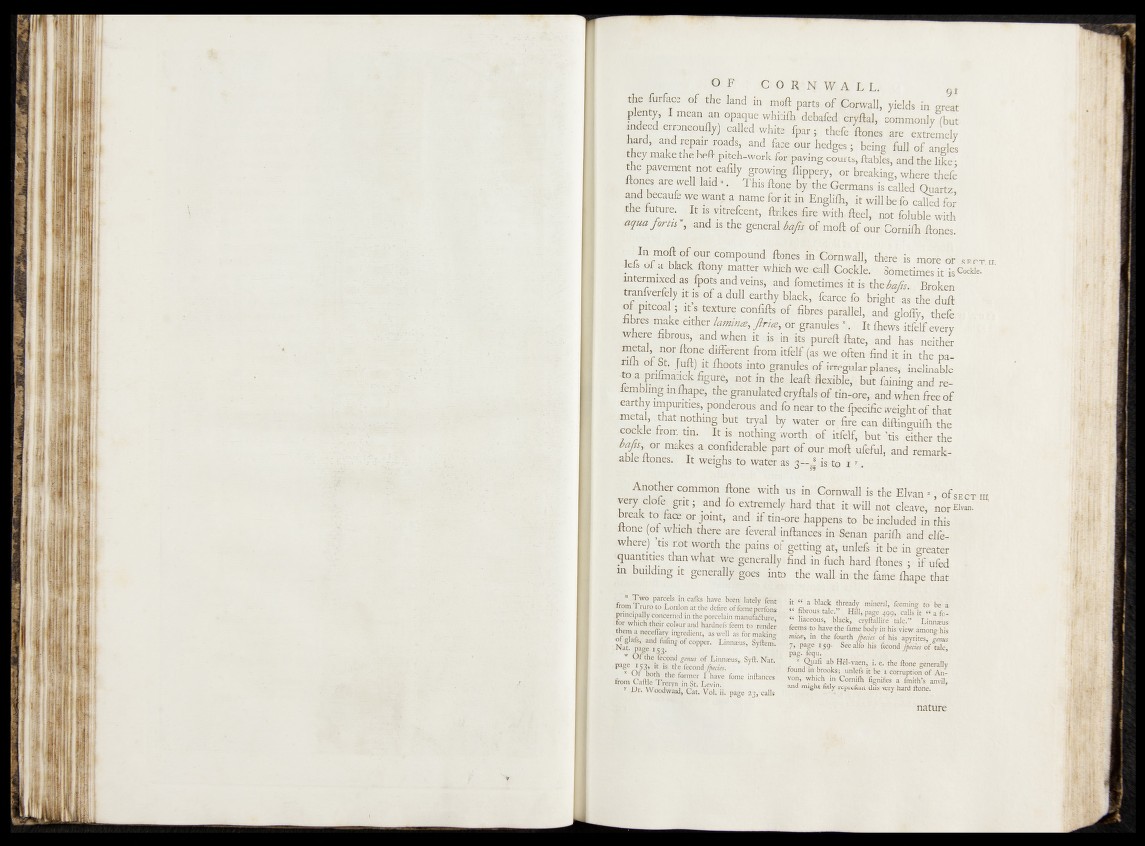
C O R N W A L L 9 ,
the furface of the land in moft parts ó f Corwall, yields in great
plenty, I mean an opaque whitifh debafed cryftal, commonly (but
indeed erroneoufly) called white fpar; thefe ftones are extremely
reP ^ 7 ° ads/ I l m our hedges ; being full of angles
Î 7 ke hç beft P^Çh-work for paving courts, fiables, and the like;
the pavement not eafily growing, flippery, or breaking, where thefe
flop j are well laid «. 3Pks ftone by the Germans is called Quartz
and became we want a name for it in Englifh, it will be fo called for
the future. It isyitrefcent, ftrikes fire with fteel, not foluble with
aquafortis , and is the general bafts of moft o f our Cornifh ftones.
o f our e x p o u n d ftones m & w a f l , there is moré or s e c t n
Ids of a black ftony matter which we call Coçkle. Sometimes it is c°du*
intermixed as fpots and veips, A f l o p it is ths hafts. Broken
tranfverfely it is' o f à dull earthy black, fcarce fo bright as the duft
o f pitcoal ; its texture confifts,-.of; fibres papjOid, and gloffy, thefe
fibres.make cither lamina, firm', ;or granules 1 . It fhews itfelf every ■
■ where fifin g , and when it is int%s pireft fete , .and has neither
metal, norftone different from itfelf (as we often find it in the pa-
f i § of .^ Inft) ft ihoots into granules of irregular planes, inclinable
-to a prifinaödc figuré, not in the Jeaft flexible, but fhining and re-
kmbhng mfhape, the granulated ctyftals o f tin-ore, and when free o f
:eartfay impurities, ponderous and fo nèar to the fpecific weight of that
metal, .that nothing but tryal by water or fire can diftinguifh the
■ codde from tin. It is nothing worth of itfelf, but ’tis either the
makes a^hfiderable; part of our moft ufefiil, and remark-
labie fiones. It weighs to water as ^T-^jis to z 7.
Mother common ftone with us in Cornwall is the Elvan *, ofsKernr.
very dofe, grit; and fo extremely hard that it will not cleave, norEi™.
break to face or joint, and if tin^ore happens to be included in this
itone (of which there are feverd; internees in Senan parifh and elfe-
Where) tis not worth the pains o f getting at, «nids it be in greater
Quantities than what we generally find in fuch hard fiones ; if ufed
in building it generally goes into the wall in the fame fhape that
0 Tw o parcels in calks have been lately feht
from Truro to London at the defire of fome perfons
.principally concerned in the porcelain manufe&imi;
for which their colour and hardnefs' feem to- render
them a neceflary ingredient, as well as for making
o f glafs, and fufing of copper. Linmeus, Syftemi!
' Wat. page 153.
w O f the ficond goats of Linnseus,, Syft. Nat.
Pag= 153, it is the fecondfruits.
* ° f *“ * the former 1 have fome mftaiices
from Cattle Treryn in St. Levin.
r Dl% Woodward, Cat. Vol. ii. page 23,-calls
it cc a black thready mineral, feeming to be a
H* tyrous talc.” , Hill, page 499, calls It « a fo.
“ Haceous, black, cryftallme talc.” Linnseus
feems to have the fame body in his view among his
mica, in the fourth Jf*dts of his apyrites, goats
7» Page i.S9 - Seealfo his fecond Jpecies o f talc,
ppg. fequ. ......
* Quafi ab Hel-vaen, i. e. the ftone generally
found in brooks; unlefs it be a corruption of An-
von, which in Cornilh fignifies a fmith’s anvil,
and might fitly reprefent this very hard ftone.
nature